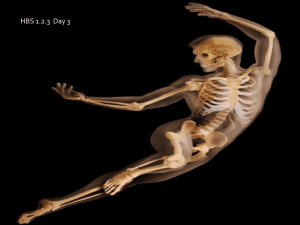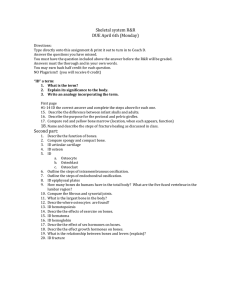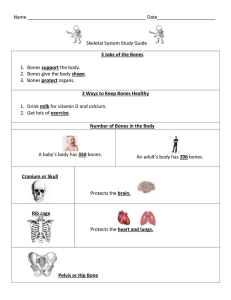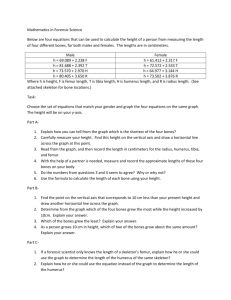Problem: ActIvIty:
advertisement
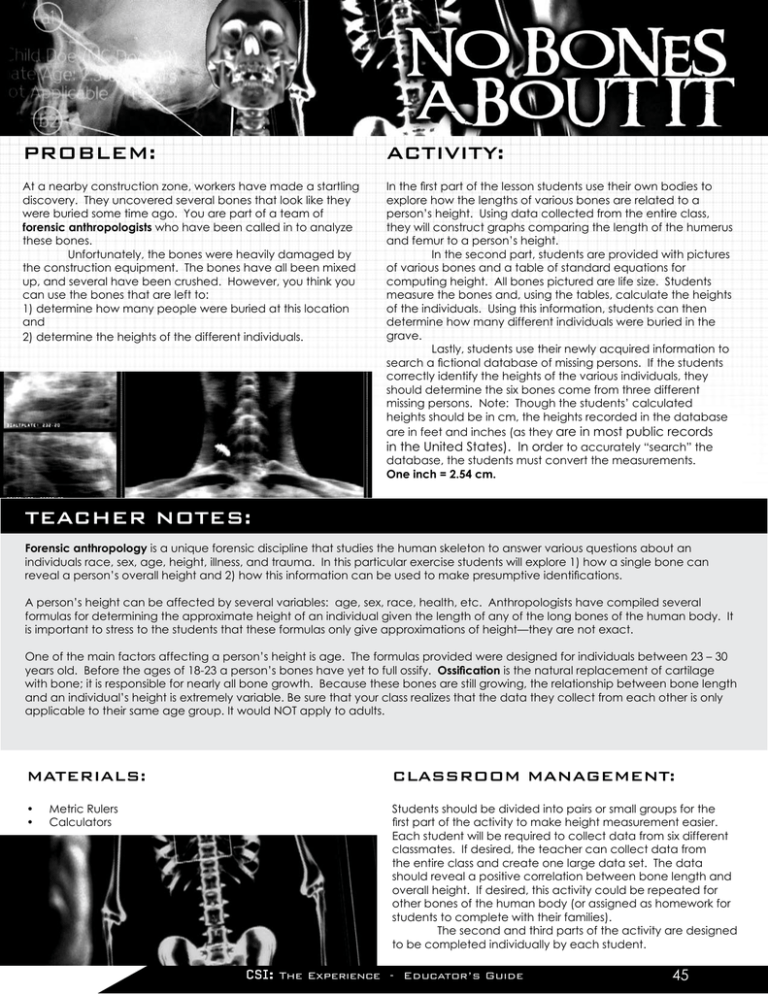
Problem: Activity: At a nearby construction zone, workers have made a startling discovery. They uncovered several bones that look like they were buried some time ago. You are part of a team of forensic anthropologists who have been called in to analyze these bones. Unfortunately, the bones were heavily damaged by the construction equipment. The bones have all been mixed up, and several have been crushed. However, you think you can use the bones that are left to: 1) determine how many people were buried at this location and 2) determine the heights of the different individuals. In the first part of the lesson students use their own bodies to explore how the lengths of various bones are related to a person’s height. Using data collected from the entire class, they will construct graphs comparing the length of the humerus and femur to a person’s height. In the second part, students are provided with pictures of various bones and a table of standard equations for computing height. All bones pictured are life size. Students measure the bones and, using the tables, calculate the heights of the individuals. Using this information, students can then determine how many different individuals were buried in the grave. Lastly, students use their newly acquired information to search a fictional database of missing persons. If the students correctly identify the heights of the various individuals, they should determine the six bones come from three different missing persons. Note: Though the students’ calculated heights should be in cm, the heights recorded in the database are in feet and inches (as they are in most public records in the United States). In order to accurately “search” the database, the students must convert the measurements. One inch = 2.54 cm. TEACHER NOTES: Forensic anthropology is a unique forensic discipline that studies the human skeleton to answer various questions about an individuals race, sex, age, height, illness, and trauma. In this particular exercise students will explore 1) how a single bone can reveal a person’s overall height and 2) how this information can be used to make presumptive identifications. A person’s height can be affected by several variables: age, sex, race, health, etc. Anthropologists have compiled several formulas for determining the approximate height of an individual given the length of any of the long bones of the human body. It is important to stress to the students that these formulas only give approximations of height—they are not exact. One of the main factors affecting a person’s height is age. The formulas provided were designed for individuals between 23 – 30 years old. Before the ages of 18-23 a person’s bones have yet to full ossify. Ossification is the natural replacement of cartilage with bone; it is responsible for nearly all bone growth. Because these bones are still growing, the relationship between bone length and an individual’s height is extremely variable. Be sure that your class realizes that the data they collect from each other is only applicable to their same age group. It would NOT apply to adults. Materials: Classroom Management: • • Students should be divided into pairs or small groups for the first part of the activity to make height measurement easier. Each student will be required to collect data from six different classmates. If desired, the teacher can collect data from the entire class and create one large data set. The data should reveal a positive correlation between bone length and overall height. If desired, this activity could be repeated for other bones of the human body (or assigned as homework for students to complete with their families). The second and third parts of the activity are designed to be completed individually by each student. Metric Rulers Calculators CSI: The Experience - Educator’s Guide 45 TEACHER ANSWER KEY No Bones About It When a body is discovered, it is important to learn as much as possible from the remains. Forensic anthropologists use mathematical formulas to estimate someone’s height from the lengths of certain bones in their body. But where do these formulas come from? 1. Using a metric ruler, measure the length of your femur (thigh bone) in centimeters. This is the large bone that runs from your hip socket to your knee cap. Record this information in the table below. 2. Have a partner measure your actual height in centimeters. Record this information in the table below. 3. Collect the same information (femur length and height) from several of your classmates. Leave the “calculated height” row blank for now. Table 1: Classroom Measurements Name Femur Length (cm) Height (cm) Calculated Height (cm) 4. Use the graph paper on the next page to graph the data you’ve collected. Use Femur Length for the x-axis and Height for the y-axis 5. Use your graph to answer the following question: What relationship is there between the length of someone’s femur bone and their height? Taller people tend to have longer femur bones. CSI: The Experience - Educator’s Guide Page 1 of 8 Page 2 of 8 TEACHER ANSWER KEY No Bones About It Anthropologists have performed hundreds of calculations like the one we just did. Their calculations showed that a person’s height can be estimated using the lengths of the long bones of the body—the femur, tibia, and fibula in the leg, and the ulna, radius, and humerus of the arm. However, the relationship between the length of these bones and a person’s height is different for men and women, and for people from different races. The table below lists all the different equations forensic anthropologist use to estimate a person’s height Table 2: formulas for calculating height BONE Femur Tibia Fibula Humerus Ulna Radius RACE MALE EQUATION FEMALE EQUATION Caucasian African-American Asian Caucasian African-American Asian Caucasian African-American Asian Caucasian African-American Asian Caucasian African-American Asian Caucasian African-American Asian 2.32 * length + 65.53 cm 2.47 * length + 54.13 cm 2.10 * length + 72.22 cm 2.28 * length + 59.76 cm 2.15 * length + 72.57 cm Not Available 2.42 * length + 81.93 cm 2.90 * length + 61.53 cm 2.19 * length + 85.36 cm 2.45 * length + 72.56 cm 2.39 * length + 81.45 cm Not Available 2.60 * length + 75.50 cm 2.93 * length + 59.61 cm 2.34 * length + 80.07 cm 2.49 * length + 70.90 cm 2.40 * length + 80.56 cm Not Available 2.89 * length + 78.10 cm 3.36 * length + 57.97 cm 2.88 * length + 75.48 cm 3.08 * length + 64.67 cm 2.68 * length + 83.19 cm Not Available 3.76 * length + 75.55 cm 4.27 * length + 57.76 cm 3.20 * length + 82.77 cm 3.31 * length + 75.38 cm 3.48 * length + 77.45 cm Not Available 3.79 * length + 79.42 cm 4.74 * length + 54.93 cm 3.32 * length + 85.43 cm 3.67 * length + 71.79 cm 3.54 * length + 82.00 cm Not Available *These formulas are calculated for adult males and females. (from Bass, W.M. (1987) Human Osteology: A Laboratory and Field Manual (3rd ed.). Missouri Archeaological Society, Columbia.) Use the table to fill in the “Calculated Height” row on Table 1. Are the results close to the actual heights? What are some possible sources of error? Results will vary. Possible sources of error include—difficulty in accurately measuring bones inside the body, natural variation among different people (equations only predict the average), and age. These equations were designed for adults; teenager height to bone length ratios are much more variable. CSI: The Experience - Educator’s Guide Page 3 of 8 LONG BONES OF THE HUMAN SKELETON Humerus Ulna Radius Femur Fibula Tibula Page 4 of 8 TEACHER ANSWER KEY No BONES ABOUT IT The following bones were recovered from the construction site. A fellow forensic anthropologist has already classified the bones by sex and race. Using the mathematical formulas from Table 2, calculate the approximate height of each individual. Table 3: Analysis of bones from construction site Bone# Type of Bone Length(cm) Race Sex Calculated Height (cm) 1 Humerus 38.2 Caucasian Male 188.5 2 Femur 44.0 African-American Female 160.1 3 Ulna 25.4 Caucasian Male 171.1 4 Femur 52.4 Caucasian Male 187.1 5 Femur 43.9 African-American Female 159.9 6 Tibia 43.7 Caucasian Male 187.7 Is it possible any of these bones came from the same person? Which bones? Bones #1, 4, and 6 could have come from the same person. Bones #2 and 5 could have come from the same person. Bone #3 must have come from a different individual. What is the minimum number of bodies buried at this site? What is the maximum number of bodies? At least three different bodies were at this site, though there may be more. For example, bones #1, 4, and 6 could have come from three different people who were all roughly the same height. Do all bones from the same body give exactly the same height? If not, why would the heights be different? Different bones from the same body can give different heights due to natural variations in arm and leg length. Also, these equations only estimate a person’s height, and estimations are rarely specific to the exact millimeter. However, we expect the heights to be close (e.g. a few millimeter different, but not a few centimeters different). CSI: The Experience - Educator’s Guide Page 5 of 8 TEACHER ANSWER KEY No BONES ABOUT IT Another forensic anthropologist on the team estimates the remains have been buried three to four years. A search of the local missing person’s database shows that the following people disappeared during that time: MISSING PERSONS DATABASE Missing Person #1 Name: Age: Sex: Race: Height: 5’0” Hair Color: Black Eye Color: Brown Dana Grant 27 F African-American Distinguishing Marks: Small rose tattoo on left ankle; appendectomy scar Missing Person #2 Name: Age: Sex: Race: Rosalyn Fairbanks 36 F Caucasian Height: 5’7” Hair Color: Black Eye Color: Green Distinguishing Marks: Wears glasses or corrective lenses Missing Person #3 Name: Age: Sex: Race: Devon Bailey 45 M African-American Height: 5’8” Hair Color: Black Eye Color: Brown Distinguishing Marks: None CSI: The Experience - Educator’s Guide Page 6 of 8 TEACHER ANSWER KEY No BONES ABOUT IT MISSING PERSONS DATABASE Missing Person #4 Name: Age: Sex: Race: Wayne Aughney 36 M Caucasian Height: 6’2” Hair Color: Black Eye Color: Brown Distinguishing Marks: Tattoo of a dragon on upper right arm Missing Person #5 Name: Age: Sex: Race: Crystal Wilson 47 F African-American Height: 5’3” Hair Color: Black Eye Color: Brown Distinguishing Marks: Large birthmark on upper back Missing Person #6 Name: Age: Sex: Race: Jessie Anderson 46 M African-American Height: 5’4” Hair Color: Black Eye Color: Brown Distinguishing Marks: Surgical scars on the back and legs due to injuries in an automobile accident Missing Person #7 Name: Age: Sex: Race: Herman Arbas 29 M Caucasian Height: 5’8” Hair Color: Blond Eye Color: Brown Distinguishing Marks: Scars on the forehead and right cheek from construction accident CSI: The Experience - Educator’s Guide Page 7 of 8 TEACHER ANSWER KEY No BONES ABOUT IT Using the database, can you determine the possible identities of the people buried at the site? Bones #1, 4, and 6 could have come from Missing Person #4 Bones #2 and 5 could have come from Missing Person #5 Bone #3 could have come from Missing Person #7 Are the heights exactly what you expected them to be? Why or why not? Answers will vary. The heights ar slightly different than the calculated values, and the possible reasons for this are varied, including: These bones do not belong to that missing person, but someone of similar height Natural variation in bone length, even between the same person’s two arms The computed heights are estimates etc What are some possible sources of error in your identification? If the person buried here had unusually long arms or legs the height estimation tables may not be accurate. If the people that are buried here are not listed as missing persons, they identifications will be wrong. If the estimations of time, sex, or ethnicity are off, the heights will not be accurate. Etc… What other forensic tests could you do to test your deductions? The next step would be to try and collect DNA samples from the bones. These samples can be used to confirm which bones came from the same buried body, and could be used to positively identify the bodies if DNA samples from the missing persons or their family members are available. Another possibility would be hiring a forensic artist to do facial reconstruction, if any skulls were found at the site. CSI: The Experience - Educator’s Guide Page 8 of 8 Name:_____________________________ Date:______________________________ No Bones About It When a body is discovered, it is important to learn as much as possible from the remains. Forensic anthropologists use mathematical formulas to estimate someone’s height from the lengths of certain bones in their body. But where do these formulas come from? 1. Using a metric ruler, measure the length of your femur (thigh bone) in centimeters. This is the large bone that runs from your hip socket to your knee cap. Record this information in the table below. 2. Have a partner measure your actual height in centimeters. Record this information in the table below. 3. Collect the same information (femur length and height) from several of your classmates. Leave the “calculated height” row blank for now. Table 1: Classroom Measurements Name Femur Length (cm) Height (cm) Calculated Height (cm) 4. Use the graph paper on the next page to graph the data you’ve collected. Use Femur Length for the x-axis and Height for the y-axis 5. Use your graph to answer the following question: What relationship is there between the length of someone’s femur bone and their height? CSI: The Experience - Educator’s Guide Page 1 of 8 Page 2 of 8 Name:_____________________________ Date:______________________________ No Bones About It Anthropologists have performed hundreds of calculations like the one we just did. Their calculations showed that a person’s height can be estimated using the lengths of the long bones of the body—the femur, tibia, and fibula in the leg, and the ulna, radius, and humerus of the arm. However, the relationship between the length of these bones and a person’s height is different for men and women, and for people from different races. The table below lists all the different equations forensic anthropologist use to estimate a person’s height Table 2: Formulas for calculating height BONE Femur Tibia Fibula Humerus Ulna Radius RACE MALE EQUATION FEMALE EQUATION Caucasian African-American Asian Caucasian African-American Asian Caucasian African-American Asian Caucasian African-American Asian Caucasian African-American Asian Caucasian African-American Asian 2.32 * length + 65.53 cm 2.47 * length + 54.13 cm 2.10 * length + 72.22 cm 2.28 * length + 59.76 cm 2.15 * length + 72.57 cm Not Available 2.42 * length + 81.93 cm 2.90 * length + 61.53 cm 2.19 * length + 85.36 cm 2.45 * length + 72.56 cm 2.39 * length + 81.45 cm Not Available 2.60 * length + 75.50 cm 2.93 * length + 59.61 cm 2.34 * length + 80.07 cm 2.49 * length + 70.90 cm 2.40 * length + 80.56 cm Not Available 2.89 * length + 78.10 cm 3.36 * length + 57.97 cm 2.88 * length + 75.48 cm 3.08 * length + 64.67 cm 2.68 * length + 83.19 cm Not Available 3.76 * length + 75.55 cm 4.27 * length + 57.76 cm 3.20 * length + 82.77 cm 3.31 * length + 75.38 cm 3.48 * length + 77.45 cm Not Available 3.79 * length + 79.42 cm 4.74 * length + 54.93 cm 3.32 * length + 85.43 cm 3.67 * length + 71.79 cm 3.54 * length + 82.00 cm Not Available *These formulas are calculated for adult males and females. (from Bass, W.M. (1987) Human Osteology: A Laboratory and Field Manual (3rd ed.). Missouri Archeaological Society, Columbia.) Use the table to fill in the “Calculated Height” row on Table 1. Are the results close to the actual heights? What are some possible sources of error? CSI: The Experience - Educator’s Guide Page 3 of 8 LONG BONES OF THE HUMAN SKELETON Humerus Ulna Radius Femur Fibula Tibula Page 4 of 8 Name:_____________________________ Date:______________________________ No BONES ABOUT IT The following bones were recovered from the construction site. A fellow forensic anthropologist has already classified the bones by sex and race. Using the mathematical formulas from Table 2, calculate the approximate height of each individual. Table 3: Analysis of bones from construction site Bone# Type of Bone Length(cm) Race Sex 1 Humerus 38.2 Caucasian Male 2 Femur 44.0 African-American Female 3 Ulna 25.4 Caucasian Male 4 Femur 52.4 Caucasian Male 5 Femur 43.9 African-American Female 6 Tibia 43.7 Caucasian Male Calculated Height (cm) Is it possible any of these bones came from the same person? Which bones? What is the minimum number of bodies buried at this site? What is the maximum number of bodies? Do all bones from the same body give exactly the same height? If not, why would the heights be different? CSI: The Experience - Educator’s Guide Page 5 of 8 Name:_____________________________ Date:______________________________ No BONES ABOUT IT Another forensic anthropologist on the team estimates the remains have been buried three to four years. A search of the local missing person’s database shows that the following people disappeared during that time: MISSING PERSONS DATABASE Missing Person #1 Name: Age: Sex: Race: Height: 5’0” Hair Color: Black Eye Color: Brown Dana Grant 27 F African-American Distinguishing Marks: Small rose tattoo on left ankle; appendectomy scar Missing Person #2 Name: Age: Sex: Race: Rosalyn Fairbanks 36 F Caucasian Height: 5’7” Hair Color: Black Eye Color: Green Distinguishing Marks: Wears glasses or corrective lenses Missing Person #3 Name: Age: Sex: Race: Devon Bailey 45 M African-American Height: 5’8” Hair Color: Black Eye Color: Brown Distinguishing Marks: None CSI: The Experience - Educator’s Guide Page 6 of 8 Name:_____________________________ Date:______________________________ No BONES ABOUT IT MISSING PERSONS DATABASE Missing Person #4 Name: Age: Sex: Race: Wayne Aughney 36 M Caucasian Height: 6’2” Hair Color: Black Eye Color: Brown Distinguishing Marks: Tattoo of a dragon on upper right arm Missing Person #5 Name: Age: Sex: Race: Crystal Wilson 47 F African-American Height: 5’3” Hair Color: Black Eye Color: Brown Distinguishing Marks: Large birthmark on upper back Missing Person #6 Name: Age: Sex: Race: Jessie Anderson 46 M African-American Height: 5’4” Hair Color: Black Eye Color: Brown Distinguishing Marks: Surgical scars on the back and legs due to injuries in an automobile accident Missing Person #7 Name: Age: Sex: Race: Herman Arbas 29 M Caucasian Height: 5’8” Hair Color: Blond Eye Color: Brown Distinguishing Marks: Scars on the forehead and right cheek from construction accident CSI: The Experience - Educator’s Guide Page 7 of 8 Name:_____________________________ Date:______________________________ No BONES ABOUT IT Using the database, can you determine the possible identities of the people buried at the site? Are the heights exactly what you expected them to be? Why or why not? What are some possible sources of error in your identification? What other forensic tests could you do to test your deductions? CSI: The Experience - Educator’s Guide Page 8 of 8
